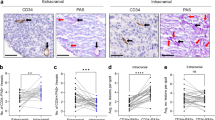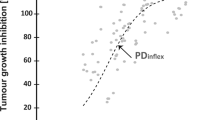Abstract
Since the introduction of the angiogenic therapy by Folkman et al. in the 1970’ies many antiangiogenic drugs were identified. Only few of them are still now in clinical use. Also the Vascular Endothelial Growth Factor (VEGF), the cytokine with the highest angiogenic activity, has been identified. Its antagonist, Bevacizumab, is produced and admitted for the angiogenic therapy in first line for metastatic colorectal cancer. When we look at preclinical studies, they fail of in vivo models that define the “Drug-AngiogenicActivity-Index” of angiogenic or antiangiogenic drugs. This work proposes a possible standardized procedure to define the “Drug Angiogenic Activity Index” by counting the vascular intersections (VIS) on the Chorioallantoic Membrane after drug application. The equation was defined as follows: {ΔVIS[Drug]−ΔVIS[Control]} / Δ VIS[Control]. For VEGF a Drug-Angiogenic-Activity-Index of 0.92 was found and for Bevacizumab a −1. This means almost that double of the naturally angiogenic activity was achieved by VEGF on the Chorioallantoic membrane. A complete blocking of naturally angiogenic activity was observed after Bevacizumabs application. Establishing the “Drug-Angiogenic-Activity-Index” in the preclinical phase will give us an impact of effectivness for the new constructed antiangiogenic drugs like the impact of effectiveness in the cortisone family.





Similar content being viewed by others
References
Folkman J (1971) Tumor angiogenesis: therapeutic implications. N Engl J Med 285:1182–1186
Folkman J (1974) Tumor angiogenesis. Adv Cancer Res 19:331–358
Hirschmann R (1992) The cortisone era: aspects of its impact. Some contributions of the Merck Laboratories. Steroids 57:579–592
Hurwitz H, Fehrenbacher L, Novotny W, Cartwright T, Hainsworth J, Heim W, Berlin J, Baron A, Griffing S, Holmgren E, Ferrara N, Fyfe G, Rogers B, Ross R, Kabbinavar F (2004) Bevacizumab plus irinotecan, fluorouracil, and leucovorin for metastatic colorectal cancer. N Engl J Med 350:2335–2342
Saltz LB, Lenz HJ, Kindler HL, Hochster HS, Wadler S, Hoff PM, Kemeny NE, Hollywood EM, Gonen M, Quinones M, Morse M, Chen HX (2007) Randomized phase II trial of cetuximab, bevacizumab, and irinotecan compared with cetuximab and bevacizumab alone in irinotecan-refractory colorectal cancer: the BOND-2 study. J Clin Oncol 25:4557–4561
Ribatti D, Vacca A, Roncali L, Dammacco F (1996) The chick embryo chorioallantoic membrane as a model for in vivo research on angiogenesis. Int J Dev Biol 40:1189–1197
Wilting J, Christ B, Bokeloh M (1991) A modified chorioallantoic membrane (CAM) assay for qualitative and quantitative study of growth factors. Studies on the effects of carriers, PBS, angiogenin, and bFGF. Anat Embryol (Berl) 183:259–271
Demir R, Hoper J (1997) Effect of beta-interferon on vascular density, mitochondrial metabolism and alkaline phosphatase in normoxia and hypoxia. Adv Exp Med Biol 428:439–447
Ribatti D, Gualandris A, Bastaki M, Vacca A, Iurlaro M, Roncali L, Presta M (1997) New model for the study of angiogenesis and antiangiogenesis in the chick embryo chorioallantoic membrane: the gelatin sponge/chorioallantoic membrane assay. J Vasc Res 34:455–463
Kunzi-Rapp K, Genze F, Kufer R, Reich E, Hautmann RE, Gschwend JE (2001) Chorioallantoic membrane assay: vascularized 3-dimensional cell culture system for human prostate cancer cells as an animal substitute model. J Urol 166:1502–1507
Author information
Authors and Affiliations
Corresponding author
Rights and permissions
About this article
Cite this article
Demir, R., Peros, G. & Hohenberger, W. Definition of the “Drug-Angiogenic-Activity-Index” that Allows the Quantification of the Positive and Negative Angiogenic Active Drugs: A Study Based on the Chorioallantoic Membrane Model. Pathol. Oncol. Res. 17, 309–313 (2011). https://doi.org/10.1007/s12253-010-9318-y
Received:
Accepted:
Published:
Issue Date:
DOI: https://doi.org/10.1007/s12253-010-9318-y




